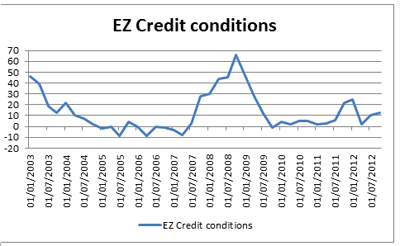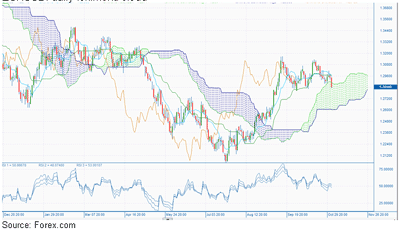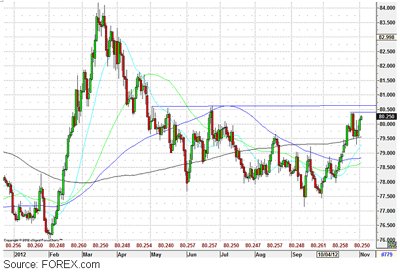Kathleen Brooks and Chris Tedder, of Forex.com highlight the events and indicators likely to shape the forex markets this week.
Decision time in the US
On Tuesday, November 6, the US heads to the polls to vote for the next President of the USA. The latest polls data put President Obama slightly ahead of his Republican rival Mitt Romney. The latest poll from Gallup found that the majority of Americans believed that Obama would win re-election over Romney. However, due to the disruption caused to polling from super-storm Sandy and with many people on the East Coast still without power, the survey data has been patchy and it is difficult to get a firm grip on the latest opinion polls with only a few days left before the election.
Obama had been ahead in Gallup’s favorability poll by 62% to Mitt Romney’s 55% prior to Sandy, and this may have increased after his tour of the Sandy-ravaged areas in New Jersey. Since Romney had to cancel last-minute campaign events, especially in key swing states, it may have negatively affected his chances of winning. It is not thought that the impact of Sandy will affect the ability of people in the East Coast to vote. Although some residents won’t be able to make it to the polls, New York and New Jersey are considered fairly safe Democratic states.
However, the devastation caused by the storm along with the pick-up in the jobs rate could benefit Obama, with only days to go before the election, as some voters may chose not to rock the boat at this stage by voting in a new leader.
The solid October jobs report was another boost to the Obama campaign. Payrolls jumped by 171k, significantly higher than the 125k expected. Although the unemployment rate picked up to 7.9% from 7.8%, it is not as bad as the headline figure suggests because there was an increase in the participation rate, which meant that some formerly disenchanted people returned to the workforce because they believe the economy can generate jobs.
There is virtually no statistical relationship between who ends up in the White House and returns on US stocks. This time round there is an extra dimension to consider: the fiscal cliff. A Congress that stays in the hands of the Republicans vs. a Democratic President could cause deadlock when it comes to negotiating whether or not to extend the Bush era tax cuts and some spending programs that expire at the start of 2013. The near miss over the debt ceiling in August 2011 saw Republicans and Democrats fail to reach an agreement to lift the debt ceiling until the 11th hour. This caused a spike in volatility, sharp declines for global risk assets, and the US to lose its triple A credit rating from S&P. Thus, the failure to hand one party a decisive victory in both Congress and the White House may spook the markets and could benefit the dollar and the yen in the short term.
The dollar had a strong end to the week on Friday. The dollar index is testing its 200-day sma at 80.65. A split vote on Tuesday may cause the dollar to get above this hurdle, which would be a very bullish development for the greenback. Likewise, stock markets could also come under pressure. The SPX 500 has backed away from the 50-day moving average at 1,435. Support lies at 1,400 then at 1,380—the 200-day sma. A split vote may cause us to get below this level to 1,350 in the short term. Back in 2011, the showdown over the debt ceiling saw the S&P 500 drop to 1,100. So the outcome of this election could have big ramifications for the markets.
NEXT PAGE: Two Different Outlooks: China & Europe
|pagebreak|China Ushers in a New Era
The other major political event next week is the 18th Communist Party Congress in China. This will see the beginning of the power shift from current President Hu Jintao to a younger leader Xi Jinping. All but two of the country’s Politburo, the country’s top political body, will step down, and two thirds of other central leadership positions are due to change hands. The markets have been well prepped for the succession, Xi Jinping was signalled as the next President as far back as 2007, thus the transfer of power should be fairly seamless.
We doubt it will have a big impact on the financial markets in the short term, but in the long-term the leader of the world’s second largest economy will shape the future direction of the global economy. While we don’t expect anything as drastic as a re-valuation of the yuan any time soon, we believe this is coming. In the summer the PBOC (Chinese central bank) announced that it was thinking of widening the band within which the USDCNH trades. This may happen once Xi has settled comfortably into the role of leader to 1.2 billion people, maybe as early as Q2 2013.
The biggest risk in the coming weeks is discord within the upper ranks of the Communist Party, after Chongqing party secretary Bo Xilai was expelled in a cloud of controversy and his wife was sentenced to death for killing a British businessman. Investigations into corruption and embezzlement at the heart of the Communist Party could cause more fallout as Xi takes office.
But luckily for Xi the economic data has started to pick up. Inflation is falling; it has dropped to 1.9% from 4.5% in January, which may help to keep social unrest to a minimum during this pivotal time. Added to this both the official and the HSBC manufacturing PMI surveys picked up in October. The industrial sector continues to grow at a healthy clip and retail sales, released next week, are also expected to increase in October relative to September.
Troubles Surface Once More for the Eurozone
This Thursday the ECB meets, which also marks the second-month anniversary of the Outright Monetary Transactions program. This program has still not been activated and right now it doesn’t look like Spain is any closer to requesting some type of financial assistance that could trigger the ECB to buy its bonds through the OMT program. Spanish bond yields remain well below their 7.5% July highs, and Q3 GDP was stronger than expected at -0.3%, which makes it even less likely that Spain will request aid before year end. However, although bond yields are stable for now it may not last long as the growth outlook for the currency bloc remains dire.
Not only did the PMI data for October remain mired in recessionary territory (apart from Ireland, which bucked the trend), but it also suggests that Q4 got off to a weak start. So far the measures adopted by governments and the ECB have not helped to boost growth. This was also highlighted in the latest ECB banking data, which showed that loans to non-financial corporations fell another 1.4% in September. The growth rate in lending data has never really recovered since the financial crisis, which could thwart growth going forward. However, the latest ECB data found that it wasn’t just greedy banks sucking up cheap money from the ECB and failing to lend it to struggling businesses, rather demand for loans remains weak. Combined with low levels of consumer and economic confidence this does not bode well for growth in the long-term, and we don’t expect a recovery in the first half of 2013. Thus, as we get closer to the end of the year the focus may shift from trying to stabilize peripheral bond markets towards reducing the intensity of austerity to try and boost growth in the medium term. The lack of growth is becoming an acute problem that is not only facing the periphery like Spain but also the core economies including Germany and France. We don’t expect any new initiatives from the ECB when it meets next week, and instead believe that Mario Draghi will press governments to stick to fiscal consolidation plans.
NEXT PAGE: Eurozone Credit Conditions
|pagebreak|Greece could also dominate the headlines next week. It still hasn’t received its latest EU 30bn bailout, and it is scheduled to run out of money mid-way through this month. This makes two Parliamentary votes scheduled for next week on the 2013 budget and pension reform even more important. Although the government is expected to win these votes it only has a slim margin and with more than 6 MPs in the opposition parties expected to vote against labor market reforms included in the budget it could be a close call. If the government does not win these votes then Greece could default, as the IMF and the EU seem unwilling to loosen terms any more than they already have done. If the votes pass then there is an increased chance of the next tranche of bailout funds being approved at the next Eurogroup finance ministers’ meeting on November 12. However, if it does not, then we may see volatility spike and peripheral bond yields start to rise.
Eurozone credit conditions: when the data ticks higher it means that credit conditions are tightening.

Click
to Enlarge
Source: ECB and forex.com
The euro ended the European session on Friday in a weak position. It fell below the top of the Ichimoku cloud at 1.2890. This is the end of the technical uptrend and may cause further selling to the 1.2830 level –m the 200-day sma, and then to 1.2750 in the near term.
EURUSD: daily Ichimoku cloud

Click
to Enlarge
Source: Forex.com
A Close Call for the BOE
Next Thursday, the BOE meets and is expected to keep interest rates and asset purchases on hold after the stunning 1.1% boost to GDP in the third quarter. However it will be a close call. The Governor of the BOE Mervyn King was particularly dovish in a recent speech and seemed to support more QE; however, other members including Charlie Bean are concerned that QE is not effective at this stage when bond yields are so low already. Added to this the BOE has always said that in November it would be able to assess the success (or not) of the BOE/government joint venture on funding for lending. There are signs that this has started to work with an increase in mortgage lending and other unsecured lending, albeit from very low rates. Added to this there is some sign that the Eurozone crisis is more stable now that the last time the Bank boosted QE in early June, and falling inflation continues to help support household spending.
We agree with consensus and expect the BOE to remain on hold this week and we don’t expect any statement. We do think the call will be close and the BOE’s outlook for growth will be cautious even after the good Q3 data. The pound has been fairly range bound in recent weeks. The market seems to have priced out the prospect of more QE already, thus we think the pound will move more on the back of overall risk sentiment, although we may see a knee-jerk reaction higher after the initial announcement. Key resistance levels lie at 1.6160 then at 1.6220.
NEXT PAGE: What’s Ahead for AUD
|pagebreak|The RBA Ponders: to Cut or Not to Cut
Go back just two weeks and around 80% of the market was predicting a 25 bps rate cut from the RBA this Tuesday, now it’s looking like a 50/50 call. Considering the mixed economic data out of Australia of late, varied signals from abroad and the lack of clear direction from the RBA, it is not hard to see why investors are so unsure about the future of monetary policy in the near-term. The situation is further complicated by varied indicators from abroad.
Last time around, the board was more dovish than the market expected, causing investors to jump to the conclusion that the RBA would loosen policy again this month. Looking over the meeting minutes and, in particular, the statement made by governor Stevens, it appears the bank was justifying its decision to trim the cash rate then, as opposed to suggesting another rate cut was on its way. Also, while the statement was overly dovish, it wasn’t bleak enough to result in a 50 bps cut, something we would expect from the bank if it was the emergency situation the market seemed to be suggesting post-cut, at least until the release of Q3 inflation data.
Also, there were a few key triggers for the October rate cut that don’t still hold true, or at least haven’t deteriorated. Namely, we have seen a turnaround in sentiment regarding the Chinese slowdown, sparked by better than expected export data, industrial production figures, and a pick-up in sentiment in the heart of the Chinese economy, the manufacturing sector. All of which points to a bottoming of GDP this quarter, as we previously anticipated. This should bode well for the main support strut of the Australia economy, the mining sector, which has been a point of concern for the RBA.
On the other hand, domestic economic data has been fairly mixed over the last month. While we saw an increase in the labor force participation rate, building approvals, home loans, and consumer confidence, the RBA is also faced will abysmal levels of business confidence, struggling non-mining sectors of the economy and a big hit to non-residential housing. Also, the RBA’s commodity price index declined during October, which raises concern about a further deterioration in Australia terms of trade.
Perhaps the most important aspect to consider, at least from a domestic perspective, is inflation. Almost single handedly, Australia Q3 CPI data turned sentiment regarding a November rate cut. Market pricing suggested that around 70-80% of investors we predicting a 25 bps rate cut before the release of the CPI data, compared with just 50% now. However, although inflation is technically around the middle of the RBA’s target range of 2-3% post release, which theoretically makes a rate cut less likely, the jump higher was largely attributable to a one time effect from the government’s carbon tax. Hence, we don’t expect to see inflation push significantly higher from here. This was backed-up by producer prices over the same period, which only increased 0.6%.
However, more often than not the bank will cut the official cash rate in consecutive months, as opposed to a single cut. Furthermore, Stevens seems to enjoy adjusting monetary policy in November, having cut rates then every year since hit took the top job in 2006. Although these aren’t fundamental reasons to cut, they do provide some insight into the psychology of the RBA board.
Overall, a case could be made for a rate cut if the RBA anticipates threats to domestic growth stemming from offshore will intensify, especially when combined Australia’s weak terms of trade and high domestic currency. While we think the RBA’s concerns about China have somewhat eased in the month, there is still the ever present threat of the European debt crisis and the fiscal cliff in the US. On balance, we are inclined to think the RBA will return to its wait-and-see mode, but it is going to be a very close call.
This week’s rate decision may lead to some very interesting and jumpy price action due to disagreement between market participations about what the RBA will do. Australia’s Q3 inflation data and the corresponding price action in the swap and interbank futures markets created room downside action in AUD if the RBA cuts the official cash rate. However, if the RBA doesn’t cut the official cash rate then we expect to see AUD leap higher. In particular, AUDJPY will be an interesting pair to watch if the RBA leaves rates unchanged, due to the dovishness coming from the BoJ.
NEXT PAGE: A Wild Week for JPY
|pagebreak|A Wild Week for JPY
The BoJ’s two-day policy meeting failed to satisfy the market and, in turn, sent investors flocking back to the yen, at least initially. At the meeting, the BoJ decided to expand its asset purchase program (APP) by JPY 11 trillion and announced the establishment of a special facility to rouse borrowing, which has the hallmarks of the LTRO operations in Europe. It wasn’t enough, however, to appease the market, which was looking for a larger expansion of the bank’s APP and a downwards revision in its 1% inflation goal. Hence, investors acted quickly to protect themselves for a push toward the yen, which inevitably sparked a drive to JPY across the board.
In a showing of unprecedented cooperation, the BoJ and Japan’s government issued a joint statement vowing to tackle deflation and return growth to a more sustainable healthy level, which is, ironically, in part being held down by a strong yen. Some people are hailing the move as just more political pressure on the BoJ to do more to stoke inflation. But there is no doubt both parties recognize the importance of assisting Japanese companies, a point which became even more relevant after a string of poor earnings announcements in the week that followed.
These earnings announcements arguably did more to weaken the yen than the BoJ’s policy announcement. The feeble results, especially on the part of Panasonic, lead to investors anticipating more easing from the BoJ further down the track and additional action to weaken the detrimentally high yen, which helped relieve some pressure on the yen. Accordingly, USDJPY was sent rocketing through 80.00. The sell-off gained momentum after the release of dovish minutes from the BoJ’s meeting in early October.
USDJPY – daily

Click
to Enlarge
Source: Forex.com
Overall, the anticipation of more easing from the BoJ and government policies also aimed at spurring inflation may put a cap on any significant JPY strength. However, given the focus on the impending presidential election in the US and the ever present threats to sentiment stemming from Europe, it is possible there may be some safe haven flows into JPY. Overall, this creates the opportunity for some range bound action for USDJPY. Key levels to watch out for in the near-term will be 80.60 and 81.85 on the upside. On the downside, if the pair pushes back below 80.00 then the its 200day SMA comes into play, which has been acting as support over the last week—currently around 79.55.
By Kathleen Brooks and Chris Tedder of Forex.com

















